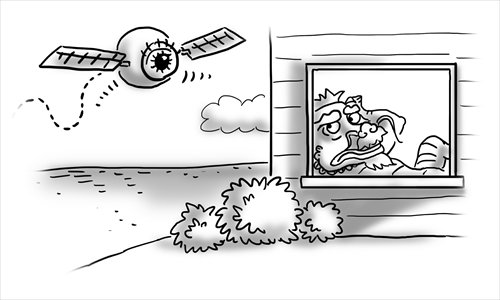India-Vietnam bond brings doubtful payoff

Illustration: Shen Lan/GT
On January 25 2016, Indian officials revealed that New Delhi would set up a new satellite tracking and imaging station in southern Vietnam. When the station is put into operation, Hanoi will have access to images from India's earth observation satellites that monitor parts of China and the South China Sea.
Although the satellite station is under Indian Space Research Organisation (ISRO) and earmarked as a civilian project, it may well be employed for military ends. The significance of the episode will go far beyond technology, especially given the geopolitical sensitivities of the region as well as the enormous military value of the high-resolution satellite images.
Vietnam often employs a rather cautious, if not conservative, attitude, toward external powers' activities in the region, while India also embraces a "strategic ambiguity" on global affairs. However, when it comes to Indo-Vietnamese ties, these two countries often take explicit and proactive steps.
These moves are clearly directed at China. Hanoi is eager to team up with powers outside the region, in an effort to reinforce its position in the lingering maritime disputes. But it is also very cautious about such moves, since external intervention, especially from the West, may shake its socialist regime and destabilize society.
India is an ideal partner. First of all, it is regarded as a rising giant with promising future - well positioned to parallel China. Second, unlike other powers such as France, Japan or the US, India not only has no historical burden toward Hanoi, but also shares a nervousness about China. Outside the South Asian subcontinent, India is a non-interventionist and shows little interest in Vietnam's domestic agenda.
Vietnam is also an ideal partner. In order to balance China's "meddling into its backyard" and build on its political and economic weight in South Asia, New Delhi looked into East and Southeast Asia and developed a series of geostrategic policies from "Look East" to "Act East."
However, India's limited political and military strength can hardly manage long-distance power projection like the US. Nor can Indian science and economic standing qualify it as an appealing sponsor. Therefore, Vietnam - not too far away from India geographically, somewhat lagging in science and technology, and suspicious against China - appears to be a good candidate to cooperate with.
In a way, the satellite project epitomizes the spirit of Indo-Vietnamese cooperation. As New Delhi and Hanoi see each other as an ideal partner, they interact and cooperate closely, especially after Narendra Modi became Indian prime minister in 2014.
The joint statement issued by Modi and Vietnamese Prime Minister Nguyen Tan Dung in October 2014 when the latter visited Delhi articulated "important commitments" in five fields: defense, the South China Sea, energy, trade and investment, and space.
The satellite project is closely connected with three and a half out of these five areas: satellite tracking and imaging are directly linked to defense and space; the satellites cover South China Sea; and the two countries' energy cooperation mainly concerns offshore drilling in the South China Sea - and in disputed waters - where satellite images can be put in great use.
But the wider strategic picture may be cloudy. New Delhi's calculation is largely based on the presupposition that China deliberately contains India. However, this assumption is groundless. The Chinese presences in India's neighboring countries are more of a consequence of Beijing's intense economic ties with countries in the region, rather than a plot to deploy "a string of pearls" to check India. After all, China's enormous energy import and manufactured goods export go round India continuously and China also energizes the region with its unparalleled capacities in building infrastructure.
India plays the Vietnam card proactively in order to gain a counterweight against Beijing. Indian strategists believe that China has designed the "string of pearls" to contain India in the Indian Ocean frontier. For them, the satellite station in Hanoi is a clever countermove to break into China's backyard. This is why New Delhi often attaches more importance to Vietnam than the latter's fair share when Sino-Indian relations are concerned.
New Delhi may believe it has targeted Beijing's weak spot, but actually Indo-Vietnamese relations are never a major concern for China. After all, India is not a South China Sea country, nor does it have substantial interests in the region. Although the satellite station can be a perfect move to serve both India and Vietnam's short-term purposes, its strategic value is doubtful.
The author is a visiting scholar at Tsinghua University. opinion@globaltimes.com.cn